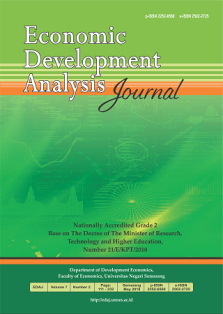The Analysis of Economic Development GAP Between Regencies in Central Java Provinces
Abstract
The purpose of this study were (1) to know how the development level of inequality of economic development in Central Java Province according to Williamson Index; (2) determine the extent of the influence of the labor force to the level of economic development of Central Java Province; and (3) know how to influence the allocation of development aid districts / cities to the economic development of Central Java province. This research is a quantitative research used panel data, time series data (years 2002-2011) and cross section (35 districts / cities in Central Java province). The data used in this research is secondary data obtained from the Central Statistics Agency (BPS). The analytical method used is the method of multiple linear regression analysis of panel data with FEM methods used tools Eviews 7 software. Results of the study is to show (1) the economic development gaps between regions in Central Java province which is calculated using Williamson index during the period 2008-2011 showed a widening inequality; (2) the allocation of development aid from the central government uneven and areas that receive aid are too large can increase the level of inequality between regions. This is due to the construction of concentrated to areas that are already developed than areas that are still lagging behind, because the area is developed better facilities from areas not yet developed; and (3) R2 value of 0.9949 means variable variation inequality of economic development in Central Java province can be explained by variables of the labor force and the allocation of regional development funds amounting to 95.5% while the remaining 0.05% is explained by other factors outside the model


